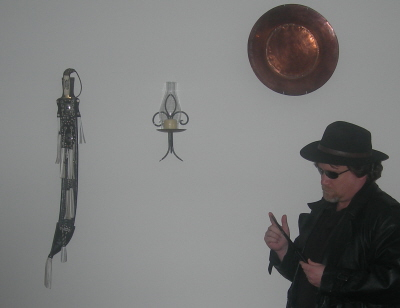|
About This Author
Come closer.
|
Complex Numbers
Complex Numbers
A complex number is expressed in the standard form a + bi, where a and b are real numbers and i is defined by i^2 = -1 (that is, i is the square root of -1). For example, 3 + 2i is a complex number.
The bi term is often referred to as an imaginary number (though this may be misleading, as it is no more "imaginary" than the symbolic abstractions we know as the "real" numbers). Thus, every complex number has a real part, a, and an imaginary part, bi.
Complex numbers are often represented on a graph known as the "complex plane," where the horizontal axis represents the infinity of real numbers, and the vertical axis represents the infinity of imaginary numbers. Thus, each complex number has a unique representation on the complex plane: some closer to real; others, more imaginary. If a = b, the number is equal parts real and imaginary.
Very simple transformations applied to numbers in the complex plane can lead to fractal structures of enormous intricacy and astonishing beauty.
| |
Today's article talks about the James Webb Space Telescope (JWST) which you might have heard of. It's kind of a big deal in astronomy. The article, however, is from last October; meanwhile, the JWST has been launched, positioned, deployed, calibrated, and tested. I mention this because some of the language in the article that is forward-looking is already obsolete. Some, but not all.
However, the article isn't really about the JWST, but focuses (see what I did there) on one astronomer.
For Quanta, that's a bit of a sensationalist headline. Or, giving them the benefit of the doubt, it's meant to be poetic.
We know next to nothing about the other 6 billion or so Earth-like planets in the galaxy.
And let me just take a break right here, because that needs some qualification.
For an astronomer, "Earth-like" has a very different meaning than it does in popular parlance. To them, Mercury, Venus, and Mars are all Earth-like. Us normies (I include myself in that group because while I'm interested in astronomy, I'm very much a spectator, not a participant) have this idea, largely promoted by SF shows such as Star Trek, that the galaxy is full of planets roughly Earth-sized with temperatures in the double digits Celsius, a biosphere and an atmosphere we can breathe -- which is what most people probably think of as Earth-like. What Trek calls "M-Class." Worse, it immediately conjures up images of space aliens living in civilizations similar to some of our own.
I'm not going to argue the "6 billion" bit, but I'm pretty sure that's a best estimate based on exoplanet findings in our stellar neighborhood.
Now, is it possible that some of those (6 billion is, after all, a very large number, on the same order of magnitude as the number of humans on Earth) are what's colloquially known as Earth-like? Sure. We don't know. That's what this article is about: us trying to get a sense of that.
However, even if they exist, that doesn't mean that there are little green astronomers there pointing their space telescopes at us. For all of Earth's history, a hypothetical alien astronomer would have pointed said telescope at us and seen absolutely no evidence that any technologically-capable species exists on it. I say for "all" of it because any such evidence is well within the rounding error for the age of the planet. So, reversing that, we could look at exoplanets for decades and not find a single one with evidence of technology happening on it. Point being, to manage expectations, we want to know what exoplanets look like -- but let's not jump right to flying saucers and shit.
More about that in another article that's in my queue. For now, back to this one.
With the imminent launch of the largest, most powerful space telescope ever built, Laura Kreidberg is optimistic this will soon change.
Like I said, obsolete. Shit's been launched. And from what I've seen, everything is proceeding smoothly. Which is actually quite remarkable considering a) how bloody complicated the engineering is and b) we once lost a Mars probe because someone confused metric and imperial units.
Kreidberg is the 32-year-old founding director of a new department at the Max Planck Institute for Astronomy in Heidelberg, Germany, devoted to studying what the weather is like on alien worlds.
I mean, think about that. The nearest extrasolar planet is roughly four light-years away, orbiting Proxima Centauri. It's (VERY) roughly 10,000 times further away from us than Neptune. Every other exoplanet is further away than that. It's only in the last 30 years or so that we even knew for certain that any of them existed, and now we're learning shit about their atmospheres. Wild.
When it comes to small, rocky exoplanets that could potentially harbor life, current telescopes lack the resolving power to do much more than tally the number that are out there.
Another qualification, courtesy of me: we have no idea what life might look like on other worlds. It doesn't necessarily require terrestrial planets to evolve; that's just our experience, sample size: 1 planet. But again, let's not conflate "life" with "technology." Don't get me wrong; finding indisputable evidence of biological processes on another planet would be a Big Fucking Deal. Just don't jump to "alien civilizations."
JWST’s distinguishing feature is a sunshield the size of a tennis court that will protect its instruments and gold-plated mirrors from the heat of the sun and Earth. Shaded in this way, the telescope will be able to detect faint infrared radiation, such as the light coming from exoplanets.
At the risk of being pedantic, I'll qualify this too. Planets don't emit their own light; what we'd see is the light reflected from the planet's star(s). That tends to be way, way dimmer than the light from the stars, so they're really hard to detect. From what I understand, it becomes easier if you just look in the infrared, which is what the JWST does. It's not just for finding exoplanets, though; distant galaxies are all redshifted enough that their light isn't in the visible spectrum at all, but downshifted into the infrared range. So the JWST is also for looking at stuff unimaginably far away.
Kreidberg, who grew up in Reno, Nevada, has been a rising star among exoplanet scientists since completing her doctorate in astronomy and astrophysics at the University of Chicago in 2016.
Science writers LOVE puns. Rising star, indeed.
Scientists suspect that life cannot survive on skyless planets, so investigating atmospheres around rocky planets is a key step toward answering the “Are we alone?” question.
Yes, life "as we know it." We can speculate all day about how life not-as-we-know-it might exist, but in practice, it's very useful to have our own baseline as a starting point. Again, though, our baseline is billions of years of nothing but single-celled organisms. They still changed the atmosphere. Finding an oxygen atmosphere would be a good sign that there's life, because oxygen is highly reactive and wouldn't stay long without there being chemical reactions, such as life, constantly replenishing it.
Anyway, I've burbled on long enough. You're better off reading what she has to say (most of the article is an interview with her).
This part is important enough to emphasize, though:
But we won’t be able to detect biosignatures, which are observable properties of a planet that can only be explained by the presence of life.
So it's probably not going to tell us there are microbes or their equivalent somewhere else. But still... it's a start.
I don't know. Maybe I'm the only one who finds this sort of thing fascinating. I try not to overwhelm my blog with such things, but sometimes I just gotta. |
© Copyright 2025 Robert Waltz (UN: cathartes02 at Writing.Com). All rights reserved.
Robert Waltz has granted InkSpot.Com, its affiliates and its syndicates non-exclusive rights to display this work.
|

